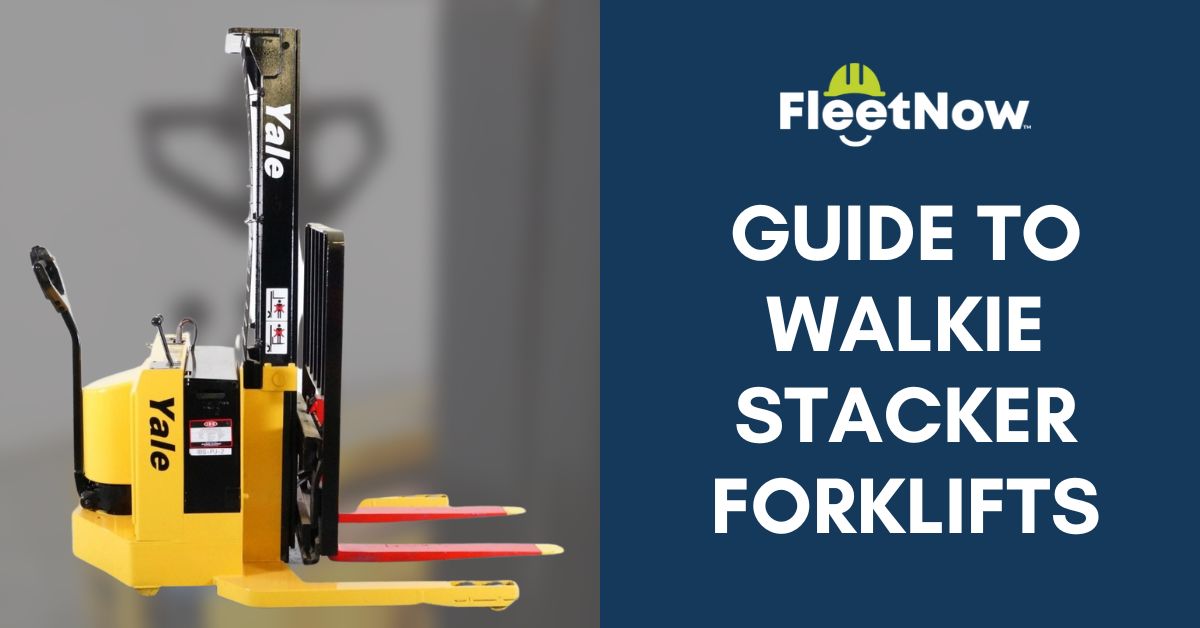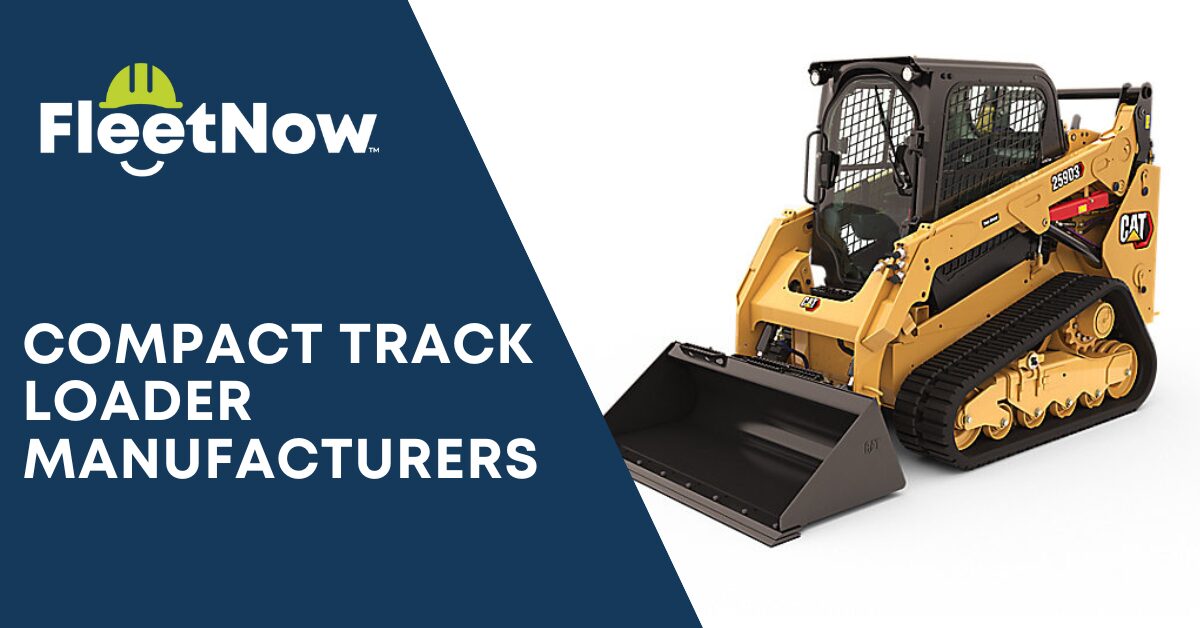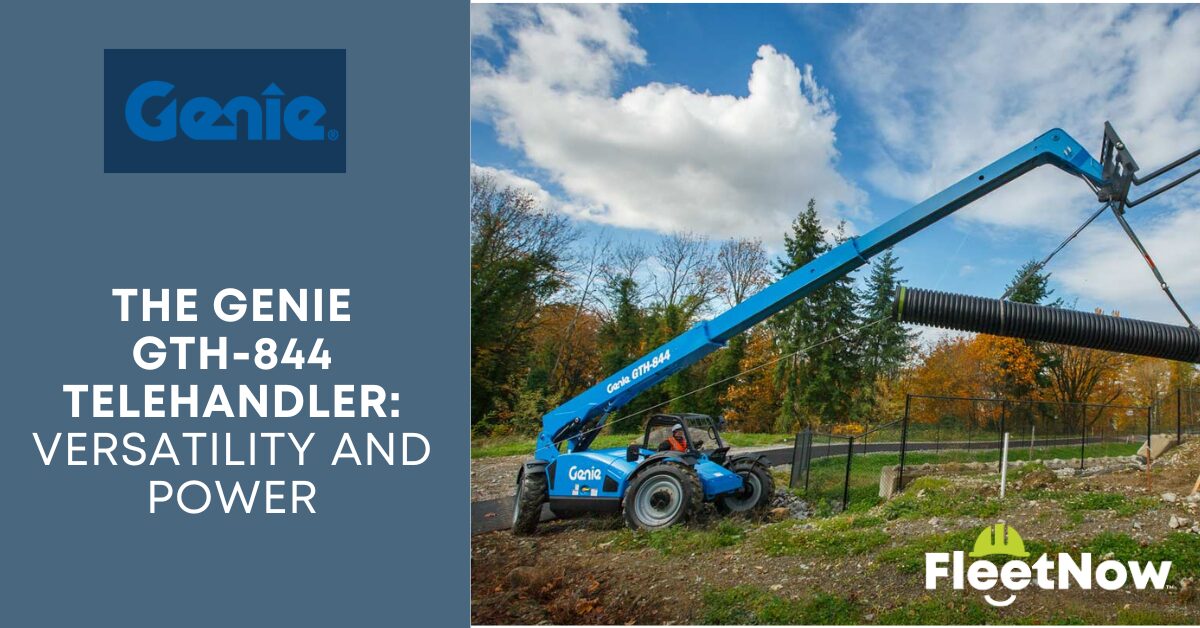Guide To Walkie Stacker Forklifts
What is a Walkie Stacker Forklift?
A walkie stacker forklift is a walk-behind pallet truck equipped with a mast for lifting pallets. It is useful for tight construction spaces where a standard lift won’t fit.
Walkie stackers, also known as straddle stackers, are used to move pallets short distances. Also, these walk-behind pallet trucks can provide a good alternative to traditional forklifts that are too big.
There are also ride-on walkie stackers and ones that require an operator to walk behind the machine. Ride-on walkie stackers allow operators to stand directly on the machine while a load is being transported.
Walkie stackers can be used to move products with a variety of different materials placed onto pallets. Walkie stackers can also transport heavy loads throughout warehouses and construction sites.
Watch this video to get a closer look at a Toyota Electric Walkie Stacker:
What are the differences between a forklift and a walkie stacker?
The are several differences between a walkie stacker and a forklift.
A walkie stacker is a manually-maneuvered, wheeled vehicle for loading, unloading, and stacking within a short distance of transportation. A forklift is an industrial transport vehicle that the operator can sit on to transport pallet goods.
Heap height is different for walkie stackers versus forklifts. Also, walkie stackers are better used for indoor jobs that require movement within tight spaces.
Walkie stacker operators have fewer licensing requirements compared to forklifts.
A walkie stacker is more environmentally-friendly and affordable than a forklift.
Walkie Stacker Uses
Walkie stackers are often used to transport goods over short distances and lift pallets when a forklift is not needed. Some environments where a walkie stacker may be used include storerooms, small warehouses, and specialized warehousing sections. It is also an economical solution for trailer loading and unloading.
Walkie stackers can typically transport 2,500 pounds or more of material. In an ideal situation, they are best used for small-capacity items transported around a warehouse or facility for less than five hours a day. They are mostly seen indoors because of their small wheels and need to move on smoother surfaces.
How do walkie stackers work?
A standard walkie stacker has legs located beneath the lift’s forks. The legs distribute load weight and ensure that an operator can lift one or two pallets at the same time.
Walkie stackers are manual or powered and are used differently by their operators.
For manual walkie stackers, operators must push the machine on their own. The stacker has a foot pedal or handle so an operator can raise the forks as needed. The operator can press a separate trigger to release pressure and lower the forks.
Powered walkie stackers require gas or electricity and often can handle larger load capacities than manual units. Operators can press a button to raise and lower the forks of a powered walkie stacker. The lift can move forward or backward with the controls on the unit’s handles.
It is not required to be certified to operate a walkie stacker, but the machine’s manual should be reviewed thoroughly before use.
How much does a Toyota walkie stacker weight?
A Toyota walkie stacker can weigh between 1,700 pounds and 6,000 pounds, depending on the type.
How high can a walkie stacker go?
Depending on the type of walkie stacker used, the machine can lift materials eight to 20 feet into the air. Counter-balance walkie stackers feature the highest lifting mast.
How much can a walkie stacker lift?
A walkie stacker can carry a load capacity between 2,200 pounds and 4,000 pounds, depending on the type. Standard walkie stackers can carry between 2,200 pounds to 3,500 pounds. Counter-balance walkie stackers have the highest load capacity.
How many hours will a walkie stacker work?
Walkie stackers that are tended to with proper maintenance intervals can last for 10 years or longer.
The battery in a powered walkie stacker can last five years or longer. Recharging the battery when it reaches 30%-20%, charging it until the battery is full, and proper cleaning can help prolong its life.
Keep in mind the older a walkie stacker gets, the more maintenance it will need.
How much does a walkie stacker cost?
The average price range for a walkie stacker, new or used, is between $2,500 and $25,000.
Who makes walkie stackers?
The top manufacturers of walkie stackers are Blue Giant, Clark, Crown, Hyster, Raymond, Toyota, and Yale.
Other brands include Barrett, Big Joe, EKKO, Gregory, JUNGHEINRICH, Octane, Prime-Mover, and Rico.
Walkie Stackers Makes & Models
Barrett: Barrett TTG-25TL, Barrett WC30, Barrett WC30TH, Barrett WC40, Barrett WS30, Barrett WS-30-TL, Barrett WS40
Big Joe: Big Joe IBH, Big Joe S22, Big Joe S22-R, Big Joe S30, Big Joe PDS25, Big Joe PDS30, Big Joe PDS40, Big Joe PDSR
Blue Giant: Blue Giant EPS-22, Blue Giant EPS-30, Blue Giant BGS-25, Blue Giant BGS-30, Blue Giant BGN-40, Blue Giant WPS, Blue Giant BGL-22, Blue Giant BGL-33, Blue Giant BGNR-30
Clark: Clark SSX18, Clark WSRX15, Clark WSTX22, Clark WS22M, Clark PWX30, Clark PWX40, Clark HWX30, Clark HWX40, Clark WPX45, Clark WP30, Clark SSX12, Clark SSX16, Clark WSTX33, Clark WSRX30, Clark WPL25
Crown: Crown 40WTT-152, Crown WS 2000-40, Crown M 3000-20, Crown ES 4000-35, Crown ST 3000-25, Crown ST 3000-30, Crown SX 3000-30, Crown SX 3000-40, Crown SH 5520-40, Crown SH 5540-40, Crown SHR 5520-25, Crown SHR 5520-30, Crown SHR 5540-35, Crown SHC 5540-25, Crown SHC 5540-30, Crown SHC 5540-40,
EKKO: EKKO EA15B, EKKO EB20E, EKKO EPE15LI, EKKO EB12E138, EKKO EK15A, EKKO EPE18LI, EKKO EK18RF, EKKO EK13A, EKKO EK20R, EKKO EP30A, EKKO EK20RL, EKKO EB12E119, EKKO ER15L-138, EKKO EB13ES-145Li, EKKO EB13E-145Li, EKKO EB13E-138Li, EKKO EB13E-LI, EKKO EB12E-98Li, EKKO EB16EAS, EKKO EB16EA, EKKO EB16EAS-189Li, EKKO EB18E, EKKO EB13E-138, EKKO EB13E, EKKO EB12EA, EKKP EB12E-138, EKKO EB12E, EKKO EA15B, EKKO EA15C, EKKO EA15D
Hyster: Hyster W25ZA2, Hyster W30ZR, Hyster W40ZA, Hyster W30ZA2, Hyster W25ZA2, Hyster W40C, Hyster W25C, Hyster W30C, Hyster SL30UT, Hyster P30UT, Hyster W45ZHD, Hyster W60Z, Hyster W80Z, Hyster W65Z, Hyster W65Z
JUNGHEINRICH: JUNGHEINRICH EJC M10 ZT 2300, JUNGHEINRICH EJC M10 ZT 2500, JUNGHEINRICH EJC M10 ZT 2900, JUNGHEINRICH EJC M10 ZT 3300, JUNGHEINRICH EJC M13 ZT 2300, JUNGHEINRICH EJC M13 ZT 2500, JUNGHEINRICH EJC M13 ZT 2900, JUNGHEINRICH EJC M13 ZT 3300, JUNGHEINRICH EMC 105, JUNGHEINRICH EMC 110, JUNGHEINRICH EMC B10, JUNGHEINRICH EJC 212b, JUNGHEINRICH EJC 214b, JUNGHEINRICH EJC 216b, JUNGHEINRICH EJC 220b, JUNGHEINRICH EJC 212, JUNGHEINRICH EJC 214, JUNGHEINRICH EJC 216, JUNGHEINRICH EJC 220, JUNGHEINRICH EJC M10 E 1540, JUNGHEINRICH EJC M10 E 1900, JUNGHEINRICH EJC M10b E 1540, JUNGHEINRICH EJC M10b 1900
Octane: Octane WS16AZ, Octane WS10, Octane WS16ZA, Octane WS12
Prime-Mover: Prime-Mover SN30, Prime-Mover PMX, Prime-Mover L36, Prime-Mover PMX45, Prime-Mover SN40, Prime-Mover WSX25, Prime-Mover WSX40, Prime-Mover RS20, Prime-Mover PE45, Prime-Mover CSX30, Prime-Mover WXR30,
Raymond: Raymond RSS 40, Raymond RAS 25, Raymond DSX 40, Raymond 6210, Raymond RCS 20, Raymond RCS 30, Raymond RCS 40, Raymond RRS 30, Raymond RSS 22, Raymond RSS 30
Rico: Rico HLW-EX-60, Rico HLW-EX-40, Rico PWH-EX-40, Rico PWH-EX-60, Rico PWH-EX-80, Rico PWH-EX-120, Rico HLW-70, Rico WR-60
Toyota: Toyota 8BWS10, Toyota 8BWS13, Toyota 6BWS11, Toyota 6BWS15, Toyota 6BWS20, Toyota 6BWC10, Toyota 6BWC15, Toyota 6BWC20
Yale: Yale MCW030LE, Yale MPW050, Yale MSW030SC, Yale MSW040, Yale MSW040SEN24TV087, Yale MSW040SF, Yale MSW040SFN24TV087, Yale MRW020E, Yale MRW030E, Yale MSW040E, Yale MSW030F, Yale MSW025F, Yale MSL30WUX, Yale MCW025E, Yale MCW040E, Yale MCW030E






